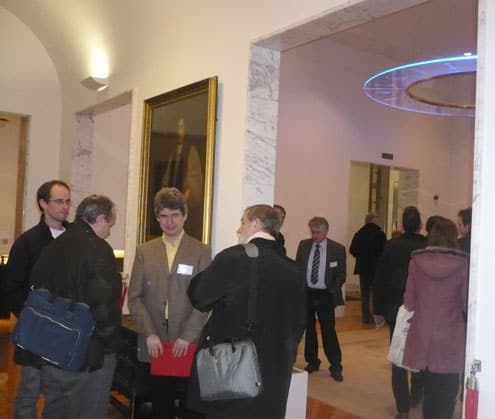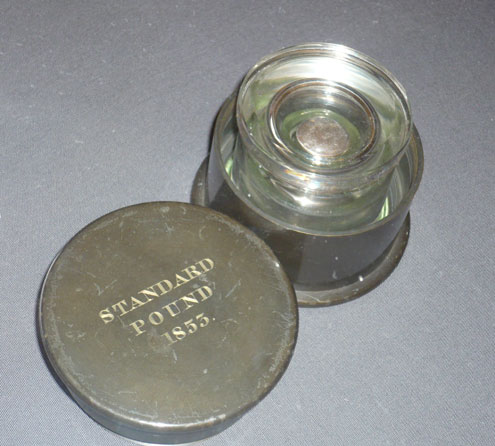By Matin Durrani

With Tunisia in political turmoil, parts of Australia under water and dozens dead in a Moscow bomb blast, a meeting on SI units in the confines of the Royal Society in London might seem absolutely right at the bottom of anyone’s news agenda. Surely the conservative world of metrology, where physicists spend years sharpening up their measurements of the seven fundamental base units, is unlikely to cause much of a stir?
But the two-day meeting, which ended yesterday, did attract a dozen or so journalists, that led to reports in the Wall Street Journal, the Guardian, New Scientist and the BBC. They were no doubt attracted in part by the presence of the world’s top metrologists, but also by the meeting’s focus: to discuss whether to revamp the SI system of units so that it is based purely on the fundamental constants of physics.
The importance of the meeting was underlined by the fact that the organizers had managed to snare the UK’s minister for universities and science David Willetts, who in his opening remarks gave a good impression of at least seeming to understand what metrology is all about; he isn’t nicknamed “two brains” for nothing.
As Willetts pointed out (thanks no doubt to his speechwriters), metrology and the measurement system are important on three counts. First, it’s vital for us as consumers to be confident about what we buy – we don’t want to be ripped off at the checkout with an underweight bag of carrots or, more seriously, be given the wrong dose during radiotherapy for cancer treatment. Second, metrology is key for advanced technology – accurate timekeeping via atomic clocks has proved essential for GPS, for example. Third, and this is what the meeting was about, the work is essential if we are to define our measurement system entirely in terms of fundamental constants.
That’s the name of the game in metrology these days – finding a way of defining mass without just resorting embarrassingly, as we do now, to a lump of metal in the basement of the International Bureau of Weights and Measures (BIPM) outside Paris and saying “that’s a kilogram”. After all, periodic inspections of the lump have shown it’s been changing its mass slowly over time. As laser physicist Bill Phillips from the National Institute of Standards and Technology (NIST) told delegates during one question-and-answer session on Monday, “It’s a scandal that we’ve got this kilogram hanging around that’s changing its mass”.
In among the audience at the meeting was Physics World columnist Robert Crease from Stony Brook University in New York, who in December wrote about visiting the BIPM last autumn for what could be one of the last ever annual inspections of the kilogram. Crease was on hand to get the latest goings-on among the world’s metrology community for a feature on the redefinition of the kilogram in the March issue of Physics World magazine – so keep an eye out for that.
But redefining the kilogram is not that easy. One option is to take a large, nearly perfect silicon sphere, count how many atoms are in it (which determines Avogadro’s constant) and then multiply that number by the mass of each atom. If you’re interested, a new paper in Physical Review Letters provides the most accurate value for the Avogadro constant to within 30 parts in a billion – the result of a collaboration between eight different national metrology institutes around the world.
The other is to use a “Watt balance”, which does not require big collaborations, but is conceptually harder to understand. It involves balancing the force through a coil with the mass of an object, and then doing another bit of jiggery pokery involving the quantum-Hall effect (to measure resistance) and the Josephson junction (to measure voltage).
The plan is for the world’s metrology community – represented by the CIPM – to put forward a proposal at its meeting next October that the SI system should be revamped. That proposal will go to the organization to which the CIPM reports – the General Conference on Weights and Measures (CGPM) – which is basically a bunch of diplomats in a smoke-filled room (without the smoke). If they give it the nod, well then it’s time to rewrite the physics textbooks.

In the current system, the kilogram, ampere, kelvin and the mole are all linked to exact numerical values of the mass of the international prototype kilogram in Paris, the permeability of the vacuum, the triple-point temperature of water, and to the molar-mass of carbon-12 respectively. The plan is to change all that so that these four units are linked to exact numerical values of the Planck constant, the charge of the electron, the Boltzmann constant and to the Avogadro constant respectively.
It’s likely that the CIPM proposal will seek to redefine the kilogram in terms of Planck’s constant when and if the experiments – the Watt balance and the Avogadro approach – come into reasonable agreement. Which they aren’t now. The metrologists clearly don’t want to play favourites regarding the technology, if only because they don’t want to get burned if one or the other doesn’t live up to promises.
As you can see, and as I soon discovered at the meeting, there’s more – much more – to SI units than meets the eye. And without wanting to steal Crease’s thunder – he’s busily putting the finishing touches to his Physics World feature on a plane back to the US as I write – I think I had better stop.
Just to say that on display in the foyer at the Royal Society are copies of what used to be known as the “standard yard” and the “standard pound” (see above), which made the venue a suitably appropriate place for this week’s meeting. I can’t help feeling, though, that despite the flaws of artefacts like the standard pound, there’s more of an emotional connection with a real object like it than a seemingly esoteric definition based on the Planck constant.



